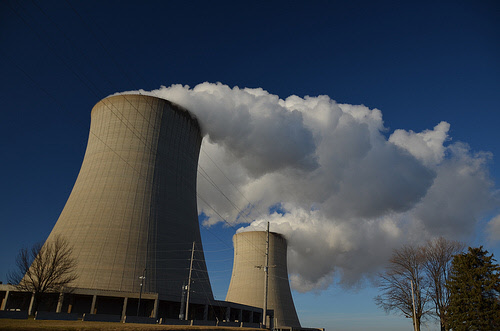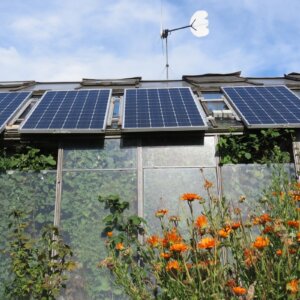Nuclear power generation in the United States is falling. After increasing rapidly since the 1970s, electricity generation at U.S. nuclear plants began to grow more slowly in the early 2000s. It then plateaued between 2007 and 2010—before falling more than 4 percent over the last two years. Projections for 2013 show a further 1 percent drop. With reactors retiring early and proposed projects being abandoned, U.S. nuclear power’s days are numbered.
The nuclear industry’s troubles began well before the 1979 accident at Pennsylvania’s Three Mile Island nuclear plant sowed public mistrust of atomic power. In 1957, the country’s first commercial nuclear reactor was completed in Pennsylvania. By the mid-1960s, excitement over an energy source predicted to be “too cheap to meter” had created a frenzied rush to build reactors. But utilities soon pulled back on the throttle as the realities of construction delays and cost overruns sank in. Annual orders for new reactors, which peaked at more than 40 in 1973, fell sharply over the next several years. The two reactor orders placed in 1978 would be the last for three decades.
Of the 253 reactors that were ordered by 1978, 121 were canceled either before or during construction, according to the Union of Concerned Scientists’ David Lochbaum. Nearly half of these were dropped by 1978. The reactors that were completed—the last of which came online in 1996—were over budget three-fold on average.

By the late 1990s, 28 reactors had permanently closed before their 40-year operating licenses expired. A number of factors played a role in this, including cost escalation, slower electricity demand growth, and a changing regulatory environment. Despite these closures, the United States was still left with 104 reactors totaling some 100 gigawatts (100,000 megawatts) of generating capacity—by far the most of any country.
Then, spurred on by new tax credits and loan guarantees promised in the 2005 Energy Policy Act—as well as by high prices for natural gas, a competing fuel—the industry has recently had visions of a “nuclear renaissance.” By 2009, utilities were planning more than 30 new reactors. But in the years since, the vast majority of these plans have been shelved. Even with huge subsidies, private lenders still see new nuclear projects as too risky to finance. Meanwhile, the U.S. shale gas production boom sent natural gas prices plummeting, further darkening nuclear’s prospect.
In 2012, the U.S. Nuclear Regulatory Commission (NRC) approved four new reactors for construction, two each at the Vogtle plant in Georgia and the Summer plant in South Carolina. These reactors are all of the same commercially untested design, purportedly quicker to build than previous plants. Both projects benefit from fairly new state laws that shift the economic risk to ratepayers. These “advanced cost recovery” laws, also passed in Florida and North Carolina, allow utilities to raise their customers’ rates to pay for new nuclear plants during and even before construction—regardless of whether the reactors are ever finished.
Construction at both sites began in March 2013. Even as the first concrete was poured at the $14-billion Vogtle project, it was reportedly 19 months behind schedule and more than $1 billion over budget. The Summer project, a $10 billion endeavor, also quickly ran into problems. In June its owner, Scana Corp., admitted that it was running about a year behind and faced $200 million in additional costs. With these delays, the earliest projected completion date for any of these reactors is some time in late 2017.
The only other reactor currently under construction in the United States is Watts Bar 2 in Tennessee. It broke ground in 1972 and, after being on hold for two decades, was finally scheduled for completion in 2012. But that year, the owner—the Tennessee Valley Authority—announced it would be delayed again until 2015 and that the cost of the project would rise by up to 80 percent, to $4.5 billion.
Several utilities have recently dropped plans for new reactors or for “uprates,” where an existing reactor’s generating capacity is increased. For example, in May 2013 Duke Energy suspended its application to the NRC for two proposed reactors in North Carolina, citing slow electricity demand growth. Then in August, Duke pulled plans for a two-reactor, $24.7-billion project in Florida, on which it had already spent—and mostly recovered from its ratepayers—$1 billion. The company worried that mid-2013 amendments to the state’s advanced cost recovery law would make it more difficult to fund ongoing projects with higher customer bills.
In June, the nation’s largest nuclear utility, Exelon, canceled uprate projects at plants in Pennsylvania and Illinois. (These are two of at least six uprates dropped by utilities in 2013 as of early September.) Just over a month later, the French utility Électricité de France (EDF) announced it was bowing out of a partnership with Exelon that operates nuclear plants in New York and Maryland. In fact, EDF will no longer pursue U.S. nuclear projects at all, instead focusing its U.S. efforts on renewables.
This year has also already witnessed the permanent shutdown of four reactors totaling 3.6 gigawatts of capacity. The first to fall was Duke’s Crystal River reactor in Florida. Although the plant was licensed to run until 2016, Duke decided to close it rather than pay for needed repairs. Then Dominion Energy’s 39-year-old Kewaunee reactor in Wisconsin closed, citing competition from low gas prices. It had recently been approved to operate through 2033. And in June, Southern California Edison shuttered its two San Onofre reactors after 18 months of being offline due to a leak in a brand new steam generator. These retirements leave the United States with 100 reactors, averaging 32 years in operation. (France is second, with 58 reactors.)
More closures will soon follow, particularly among the roughly half of U.S. reactors in so-called merchant areas where nuclear competes with other technologies and prices are set by the market. A 2013 report by Mark Cooper at the Vermont Law School indicates that there are nine merchant reactors that, like Kewaunee, were granted 20-year life extensions but are especially at risk of closure. Epitaphs are already being written for two of them: Vermont’s lone nuclear power plant will close in 2014, and the country’s oldest reactor, Oyster Creek in New Jersey, will retire by 2019.
“Regulated” areas, where state authorities set electricity prices such that nuclear operators are guaranteed a profit, contain the rest of the U.S. reactors. Even for many of these plants, the economics may not allow for survival much longer. According to Credit Suisse, the cost of operating and maintaining the aging reactor fleet is rising at 5 percent a year and the nuclear fuel cost is growing even faster, at 9 percent annually. Wind and solar power costs, on the other hand, continue to drop as their electric output grows rapidly.
Dealing with nuclear waste is another expensive proposition. Over the past 30 years, the U.S. government has spent some $15 billion trying to approve a central repository for nuclear waste, and for most of that time the only site under consideration has been Nevada’s Yucca Mountain. Amid concerns about the site’s safety and its extreme unpopularity in Nevada, the Obama administration has moved to abandon the project entirely and explore other options.
A federal appeals court ruled in August 2013 that the NRC must resume reviewing the site’s suitability. In the meantime, the waste keeps accumulating. The 75,000 tons of waste now stored at 80 temporary sites in 35 states is projected to double by 2055. All this has implications for nuclear power’s prospects for expansion: nine states, including California, Connecticut, and Illinois, have prohibited new nuclear plants until a solution to the waste issue is found.
The low level of liability for nuclear operators in case of an accident also puts taxpayers on the hook. Plant owners pay into an insurance pool of just $12 billion; the public would cover any further damages. For comparison, cleanup and compensation for the 2011 Fukushima nuclear disaster in Japan is projected to cost at least $60 billion. The Natural Resources Defense Council estimates that a catastrophic accident at New York’s Indian Point plant could cost 10 to 100 times that amount. This risk will be underscored on September 29, 2013, when one of Indian Point’s two reactors becomes the first ever to operate with an expired license.
If the reactors now under construction in Georgia and South Carolina actually come online, they are projected to generate electricity that is much more expensive than nearly any other source, including wind and solar power. New nuclear plants are simply too expensive to replace the aging fleet. And with uprate proposals for existing reactors being pulled, it appears the industry cannot depend on this option to increase capacity much either.
The NRC has approved 20-year operating life extensions for more than two thirds of existing U.S. reactors; most of the rest will probably be granted extensions as well. Even if these units reach the end of their licensed life—which past experience says is unlikely—if no new plants come online to replace them, the last U.S. reactor will be shut down by the late 2050s. Any industry hopes ride heavily on the success of the Vogtle and Summer projects. As U.S. Energy Secretary Ernest Moniz said in a recent interview, if these plants now under construction keep racking up huge cost overruns and delays, “it is very hard to see a future for nuclear power plants” in the United States.
Data and additional resources available at www.earthpolicy.org.
Image credit: Michael Kappel via photopin cc








































Keep your fingers limbered up to report on the upcoming US energy crisis! Within the next 5 years the current glut of fracking generated natural gas will run it’s course as utilities retool to exploit it and prices rise accordingly. It will be about then that it’s availability tapers off as the technology to produce it reaches it’s limits and the “Green” movement begins to understand it’s ecological cost. Unfortunately the “renewables” will still be far short in their capability to replace the lost nuclear capacity which will leave us with no choice but to fall back on oil and (dare I say it?) coal to keep prices down until we can regain our footing with new nuclear capability. The smart money today is on small modular reactors. So keep your eyes pealed!
DOE needs to answer for this first:
http://boycotttesla.wordpress.com/2013/07/25/the-drop
Um… yawn.
In reply to jc1255, I would respectfully suggest that the indefinitely delayed renaissance of the commercial nuclear power industry in this country is not in response to any ‘Green” movement [straw man as used here], but rather to simple economics. One does not need to be a proponent or opponent of nuclear power, instead just accept the market judgment. The costs of shale gas, photovoltaic and wind are now dropping and all other electric generation modes are increasing, but particularly nuclear Witness the recent decision by Duke Energy to cancel the Levy County pair of 1100MW plants whose projected price had ballooned from US$4B in 2006 to US$24.7B this year before they pulled the plug, with no plans to return the approximately US$1B that ratepayers are going to have to finish paying in by 2014. Paying for generation they never get to use. How many industries get to do that? Nuclear has fairly been described as one of the most socialized parts of the US economy.
Now, I will grant you that natural gas prices are inherently volatile and are clearly going to rise [perhaps dramatically] when the shale gas production trails off as quickly as the individual multilateral, directionally drilled hydrofracked wells have clearly demonstrated that they do.
But at the same time, wind turbine prices are coming down, and in 2012 nine states in this country generated at least 10% of their electricity from wind, a sustainable resource if ever there was one. Photovoltaic panels and inverters are coming down in price as well, though PV will rise some as the current Chinese oversupply is worked through.
Coal was 52% of US electric generation in 1999 and is now down to about 40%, though has dipped as low as 37% and the trend is clearly down. Don’t blame the environmental movement, this is simple economics.
As for modular reactors, I would be cautious with any investment there. The economy of scale is given up, with really no reduction in security risk, accidents, and again unenviable economics.
I am curious what others think as well. I think that the article was a cogent and responsible summation of the sad but well-earned demise of an industry.
Whether you are Pro or Anti Nuclear, Fukushima’s radioactive water is causing Global concerns and rightfully so since TEPCO’s track record at telling the truth is about as good as their handling of the triple meltdown at Fukushima.
TEPCO saves huge YEN for every liter of radioactively polluted water that escapes. leaks or is simply allowed to run either onto the ground or directly into the Pacific Ocean, via the Sea of Japan.
Once off site it is no longer TEPCO’s problem, which is wonderful for them but terrible for the res of us!
Their storage system has been designed to fail since the first tanks were built on site and those that think that TEPCO is doing everything they can to capture and hold onto this radioactive water is living in a fantasy world where TEPCO cares more about the people of Japan than they do about saving FACE and their own Profits!
We are not being told the truth about what is going on there, which is BAD news for mankind and especially the Pacific Ocean that is now a Japanese radioactive dumping ground!
Yet another Colossal FAILURE by TEPCO and the Japanese Government who “regulates” them:
Rad detectors at Fukushima Diachi read 1,800 millisieverts an hour.- BBC.http://wp.me/pDwKM-3HZ
So rather than say that the Pacific is huge and it is OK for the Japanese to keep dumping, everyone Pro or Anti Nuclear should be asking why the Japanese are being allowed to do this, since it is putting radioactive egg on the face of entire nuclear industry, who have since 3/11/11 tried to continually downplay any and all negative information that challenges nuclear as being unsafe!
What could possible go wrong with a Nuclear Power Plant (NPP)?
Anyone or more of these:
~ Tornado strike?
~ Earthquake?
~ Human error?
~ Tsunami?
~ Power outage?
~ Pipe break?
~ Test gone wrong?
~ Old fuel issues?
~ Terrorist attack?
~ Hurricane?
~ Plane crash?
~ Heavy rains/River floods?
~ Metal Fatigue?
~ Nuclear Ransom?
~ Solar Flair?
~ EMP?
~ Lightning?
~ Dam Failure?
~ Fire?
~ Operator suicide?
~ Jihadist?
~ CME?
~ Carrington Effect?
~ Cyber-warfare?
~ Meteror?
~ Aliens?
~ Volcano/Eruption?
~ Stuxnet ?
~ Bad Luck?
~ Murphy’s Law?
… Just to name a few possibilities of how NPP’s can fail.
Here is what Former Japanese PM Kan (1), Gregory Jaczko (2) the Former Chairman of the Nuclear Regulatory Commission and 2 other Nuclear Experts (3) had to say at a June 4, 2013 seminar in San Diego,CA, “Lessons for California” which was based upon what they experienced as the Leaders “in-charge” when 3/11/11 occurred:
(1) http://www.youtube.com/watch?v=nAYVK8_W2h4
(2) http://www.youtube.com/watch?v=AG1QmEQ84aY
(3) http://www.youtube.com/watch?v=8g6mViUvHUo
Uprate’s: Big Profits for Utilities & Big Losses for Ratepayers
Uprate’s allow more power to be generated which is wonderful for the Utilities bottom line (additional profits from same “old” nuclear power plant (NPP), but it is never mentioned that generating that additional power increases the wear and tear on the NPP, which the ratepayers, not the Utility, have to pay for!
At San Onofre NPP in CA (which is also now being decommissioned), SCE wanted to install new replacement steam generators (RSG’s) so they could generate more power and make more profits but their poor in-house design resulted in their RSG’s failing soon after being installed! Now ratepayers have pushed the CA Public Utility Commission (CPUC) into demanding an investigation into the reasonableness of all the monies spent in order to determine what amount of money should be rebated to ratepayers. Estimates of total cost of their debacle as 13 billion dollars, yet the Utility is claiming they are not responsible! Note, because the NPP was decommissioned prematurely, there is now a shortage of money to decommission the NPP of about 740 million dollars, since this money is collected from ratepayers while the NPP is in service. So get ready ratepayers in VT, chances are that you will soon be learning that you are going to have to pay for any shortage in decommissioning costs that have not been already collected.
Uprating is only a good deal for the Utilities and their shareholders who do not have to pay for the increased maintenance costs required by the uprate due to higher corrosion rates and fatigue stress, which are just past along to the ratepayers, as part of the NPP’s ongoing maintenance. Remember, if additional maintenance is required, the Utility also profits from that “extra” work so there is little incentive to prevent wear and tear, especially when Utility profits are at stake!
Great article:
Flare-up: How the Sun Could Put an End to Nuclear Power
http://www.earthisland.org/journal/index.php/ei…
BY GAR SMITH
snip
Solar energy may soon eclipse nuclear power – only not in the way we hoped. According to NASA, the planet will soon face an outbreak of powerful solar flares capable of collapsing global power grids. Were this to happen, the world’s nuclear reactors could be left to run wild, overheat, melt, and explode.
The sun’s magnetic cycle peaks every 22 years while sunspot activity crests every 11 years. Both events are set to peak in 2013. Coronal Mass Ejections (CMEs) trigger geomagnetic disturbances (GMDs) – tides of high-energy particles that can disrupt power lines. Since the 1970s, the array of high-voltage transmission lines spanning the US has grown tenfold. NASA warns these interconnected networks can be energized by a solar flare, causing “an avalanche of blackouts carried across continents [that] … could last for weeks to months.” A National Academy of Sciences report estimates a “century-class” solar storm could cause 20 times the damage as Hurricane Katrina while “full recovery could take four to ten years.”
FACT: A once in a hundred year or even a thousand year event is just as likely to happen tomorrow as many years in the future; then what?
This is where the NRC and the nuclear Industry fails the public trust because they live in Nuclear Denial* because they believe nothing BAD will happen to any Nuclear Power Plants (NPP’s).
Example:
French Nuclear Disaster Scenario Was So Bad The Government Kept It Secret http://www.businessinsider.com/potential-cost-o… via @bi_contributors
snip
Catastrophic nuclear accidents, like Chernobyl in 1986 or Fukushima No. 1 in 2011, are, we’re incessantly told, very rare, and their probability of occurring infinitesimal.
But when they do occur, they get costly. So costly that the French government, when it came up with cost estimates for an accident in France, kept them secret.
But now the report was leaked to the French magazine, Le Journal de Dimanche. Turns out, the upper end of the cost spectrum of an accident at the nuclear power plant at Dampierre, in the Department of Loiret in north-central France, amounted to over three times the country’s GDP.
* http://is.gd/XPjMd0
The illogical belief that Nature cannot destroy any land based nuclear reactor, any place anytime 24/7/365!
CaptD, don’t be so bloody tiresome.
I’m totally speechless at the comments, especially about the sun spots. I’m planning on installing solar panels on my roof and am wondering if that solar activity would adversely affect them.
Diane C, forget it. It’s nonsense. Yes, solar eruptions can potentially disrupt by EM induction large above-ground electric grids (esp. a so-called Carrington event, last seen 1859) but individual solar panels are not at risk. Do your economics and enjoy 😉
CaptD is a nitwit loudmouth, pardon my French.